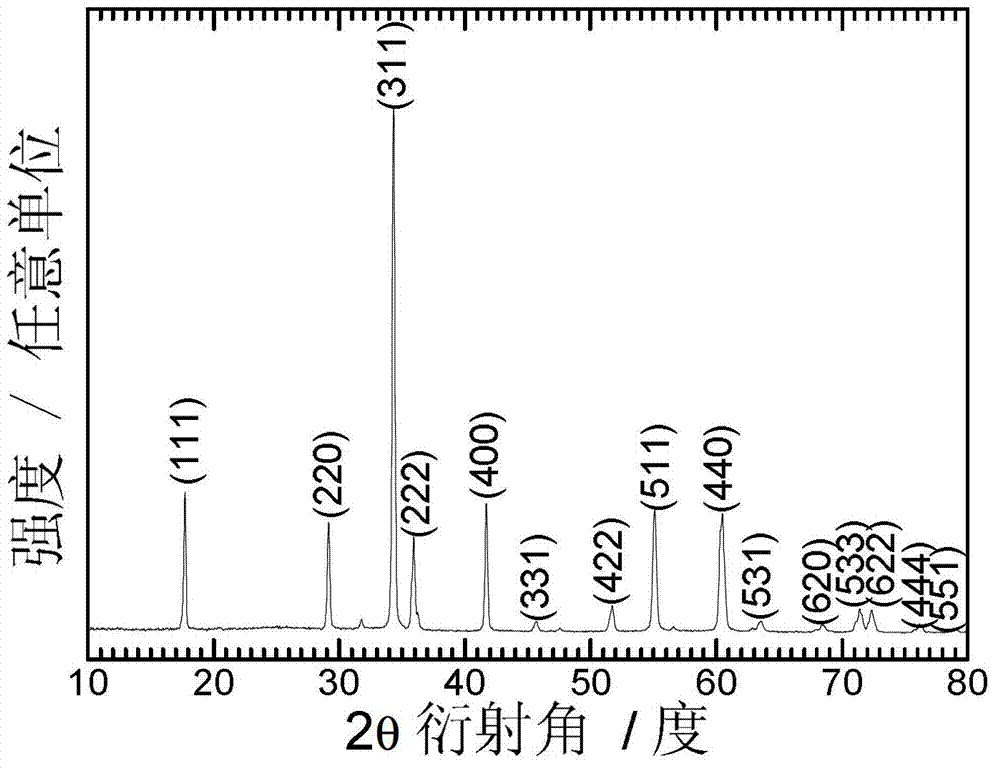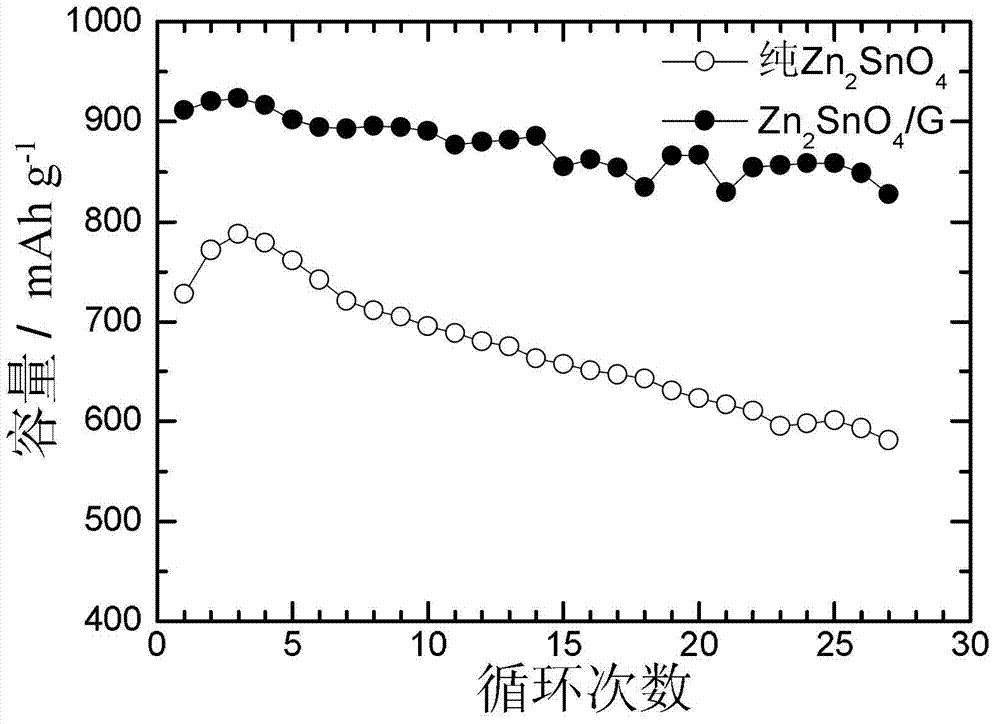Tin-base complex oxide/graphene composite material, and preparation method and application thereof
A technology of composite materials and oxides, applied in electrical components, battery electrodes, circuits, etc., can solve the problems of capacity attenuation, large volume change, etc., and achieve the effects of small particle size, simple process, and low energy consumption
- Summary
- Abstract
- Description
- Claims
- Application Information
AI Technical Summary
Problems solved by technology
Method used
Image
Examples
Embodiment 1
[0035] SnCl with a molar ratio of 1:2 4 ·5H 2 O and CoCl 2 ·6H 2 O was dissolved in deionized water to make 80 mL of Sn 4+ and Co 2+ Total concentration is 0.015mol / L and the solution of 0.015mol / L, add 36 milligrams of GO again and make mixed solution; The mixed solution is placed in the capacity and is in the autoclave (filling degree 80%, volume percentage) of 100 milliliters, and then with 6mol / L NaOH aqueous solution to adjust the pH value to 12, then seal the reactor, react at 200°C for 36 hours, and cool to room temperature naturally; collect the solid reaction product, wash the product alternately with deionized water and absolute ethanol, and dry it. Obtained 0.13g Co 2 SnO 4 / graphene composite material, wherein the weight percentage of graphene is 11%.
[0036] The X-ray diffraction spectrum and transmission electron microscope photograph of the composite material of gained are respectively as follows figure 1 and figure 2 , where the X-ray diffraction pea...
Embodiment 2
[0039] SnCl with a molar ratio of 1:2 4 ·5H 2 O and Ca(CH 3 COO) 2 ·H 2 O dissolved in 1-butanol to make 80 mL of Sn 4+ and Ca 2+ Total concentration is the solution of 0.03mol / L, add 42 milligrams of GO again and make mixed solution; The mixed solution is placed in the capacity and is in the autoclave of 100 milliliters (filling degree 80%, percent by volume), adjust pH with 25wt% ammonia water The value was adjusted to 9, then the reactor was sealed, reacted at 180°C for 48 hours, and cooled to room temperature naturally; the solid reaction product was collected, washed repeatedly with deionized water and absolute ethanol, and dried to obtain 0.23g Ca 2 SnO 4 / graphene composite material, wherein the weight percentage of graphene is 7.4%.
[0040] It can be seen from the X-ray diffraction pattern and the transmission electron microscope photo of the composite material obtained that the composite material obtained is Ca 2 SnO 4 / graphene composites, where Ca 2 SnO ...
Embodiment 3
[0043] K with a molar ratio of 1:2 2 SnO 3 ·3H 2 O and MgSO 4 ·7H 2 O was dissolved in absolute ethanol to make 80 mL of SnO 3 2- and Mg 2+ Total concentration is 0.09mol / L solution, then add 56 mg GO to prepare mixed solution; The mixed solution is placed in a capacity of 100 ml autoclave (filling degree 80%, volume percentage), with 6mol / L KOH Adjust the pH value of the aqueous solution to 10, then seal the reaction vessel, react at 220°C for 24 hours, and naturally cool to room temperature; collect the solid reaction product, wash the product alternately with deionized water and absolute ethanol, and dry to obtain 0.58 g Mg 2 SnO 4 / graphene composite material, wherein the weight percentage of graphene is 3.8%.
[0044] It can be seen from the X-ray diffraction spectrum and the transmission electron microscope photo of the composite material obtained that the composite material obtained is Mg 2 SnO 4 / graphene composites, where Mg 2 SnO 4 The particle size is i...
PUM
| Property | Measurement | Unit |
|---|---|---|
| Diameter | aaaaa | aaaaa |
Abstract
Description
Claims
Application Information
 Login to View More
Login to View More - R&D
- Intellectual Property
- Life Sciences
- Materials
- Tech Scout
- Unparalleled Data Quality
- Higher Quality Content
- 60% Fewer Hallucinations
Browse by: Latest US Patents, China's latest patents, Technical Efficacy Thesaurus, Application Domain, Technology Topic, Popular Technical Reports.
© 2025 PatSnap. All rights reserved.Legal|Privacy policy|Modern Slavery Act Transparency Statement|Sitemap|About US| Contact US: help@patsnap.com



